Ohio Secretary of State Frank LaRose said he’ll deliver a list of contingency options to lawmakers and the governor to consider in case the state needs to conduct a vote-by-mail election in November. LaRose said Ohio would need to have decisions on those options by late August.
LaRose said he’ll again advocate for a legal change to allow absentee ballot requests be made online — rather than by mail — and a system to automatically send absentee ballot applications to all voters, provide for pre-paid postage, increase county boards of elections staffing and reduce the total number of polling places.
League of Women Voters of Ohio Executive Director Jen Miller said Ohio should just assume that voters will prefer and health care professionals will recommend voting by mail in the November general election. Ohio should adopt a system in which every registered voter is automatically mailed a ballot and eliminate the need to request one, she said.
Nearly three in 10 Americans believe the November election may not proceed on time as planned, according to a national poll conducted by Grinnell College from March 27-30.
DETAILS:
Coronavirus: Food stamp demand soars in Ohio
“We have time to emulate a true vote-by-mail process, which means every voter gets a ballot,” Miller said.
LaRose said he’d be willing to consider mailing ballots to all registered voters, provided Ohio’s registration rolls are clean and up to date.
Changing how Ohio votes requires approval from lawmakers. Election reform legislation sometimes takes years to win approval from lawmakers who typically have a strong self-interest in it.
“It’s a matter of educating the (Legislature) members, listening to their input, being open to changes,” said LaRose, who is a former state senator.
READ MORE: Woman whose family called to say goodbye to her survives after first COVID-19 trial
Currently, Ohio is conducting the first vote-by-mail primary in state history. After the Ohio Department of Health closed polling places on March 17, lawmakers passed an emergency bill that extends mail-in voting to April 28. Ballots must be postmarked by April 27 to be counted.
As of Tuesday, April 21, more than 975,150 Ohioans had cast a mail-in ballot, according to LaRose’s office. LaRose fired off a letter to Ohio’s Congressional delegation on Thursday, asking for help with mail delivery delays. The U.S. Postal Service says first class letters take one to three days to deliver, but it’s taking seven to nine days to deliver in some areas, LaRose said.
President Donald Trump has cast doubt on the security of mail-in voting, saying in recent tweets that it increases the risk for crime and voter fraud.
LaRose responded by tweet: “I can tell you that’s not the case in Ohio. As I’ve said, we’re fortunate that we’ve been doing vote by mail for a long time. We know how to do it, and we know how to get it done securely. Hope we can get back to normal for November, but we’ll be ready no matter the situation.”
Bob Taft, who served a combined 16 years as Ohio governor and secretary of state, said state leaders should be putting plans in place now for an all mail-in general election — just in case.
“They’ve got to be all over it now because it’s a real possibility that we’ll have to do this,” said Taft, who now teaches political science courses at University of Dayton.
The logistics, legalities and finances of running an all mail-in election are complicated and need to be worked out well in advance, he said.
“Every state should be considering this,” Taft said.
Taft added that he has a strong preference for in-person voting to guard against undue influence that might be exerted on citizens voting outside the privacy of the voting booth.
States run elections but U.S. Sen. Sherrod Brown is backing federal legislation that calls for expanding early in-person voting and no-excuse absentee voting to all states.
A spokeswoman for U.S. Sen. Rob Portman noted that Portman backed the CARES Act, which includes $400 million for election security grants for states.
“Rob believes it is important for state legislatures and governors to work together to figure out the best way to ensure the security of their elections and the health of their citizens, and he hopes they take advantage of the federal funding to do just that,” Portman spokesman Emmalee Kalmbach said.
Five states — Colorado, Hawaii, Oregon, Washington and Utah — conduct all elections entirely by mail and another 21 states allow smaller elections to be conducted by mail, according to the National Conference of State Legislatures. All registered voters are mailed a ballot in these elections.
Oregon became the first all-mail election state via voter approval in 1998.
Studies show turnout improves in all-mail elections because they’re more convenient and administrative costs generally decrease, NCSL reported last month.
Possible drawbacks include a loss of civic tradition, slower voter counting, mail delivery isn’t uniform across the nation and some voters might be susceptible to coercion by family members or others.
The U.S. Election Assistance Commission report said the percentage of voters casting ballots in-person on Election Day has declined while states offering early voting and absentee voting has increased. As of 2016, two in five ballots are cast early.
Aaron Ockerman, director of the Ohio Association of Elections Officials, said, “If in-person voting remains a dangerous activity, I believe we would again support doing the election by mail.”
Ohio would need at least three months lead time to pull off an all mail-in election. Key elements would be return postage paid and a mechanism to request an absentee ballot online, he said.
Things to Know about Ohio Primary this week:
• Mail-in ballots must be postmarked by April 27 to be counted.
• Ballots may be dropped off at your county board of elections office by 7:30 p.m. Tuesday.
• Votes will be tabulated starting at 7:30 p.m. Tuesday but results will be unofficial.
• Mail-in ballots must arrive by May 8 to be included in the official count.
• 482 local issues across 83 counties are on the ballot.
• Voters will cast primary ballots for president, legislative seats, Ohio Supreme Court, judicial seats, countywide offices and local races.
About the Author

